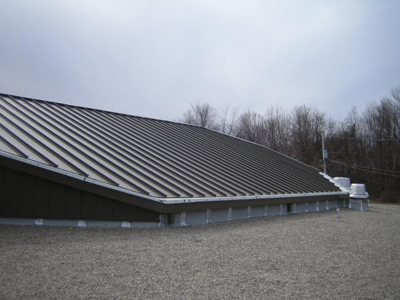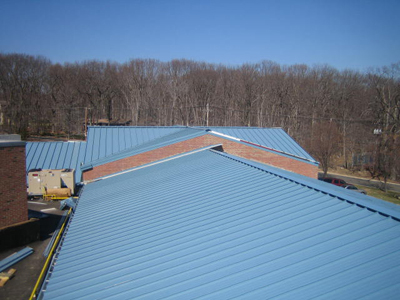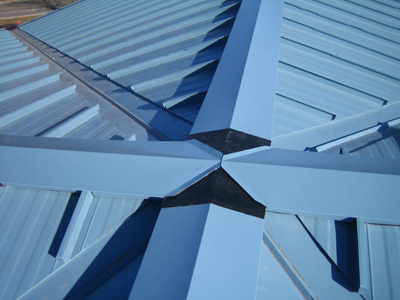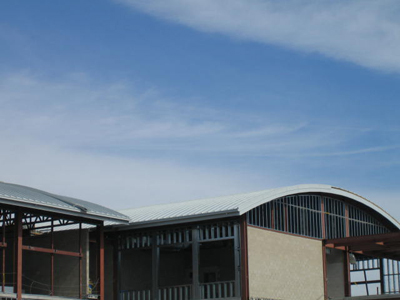 By Harry Comfort, The Garland Company Inc.
By Harry Comfort, The Garland Company Inc.
By next year (2020), the commercial and residential metal roofing market is expected to reach $4 billion, continuing a growth trend that began about three years ago. There are numerous reasons cited for the upward shift, according to Principia Consulting,
a leading research and consulting firm focused exclusively on the building materials and construction industry. One growth driver includes the fact that building owners have begun to more fully understand and accept the life-cycle cost and long-term
performance benefits of metal roof systems.
This article will explore the major benefits of metal that are driving today’s trend of choosing metal roofs and walls for the new construction and reroofing of private and public sector commercial facilities.
Functional And Aesthetic Versatility
What can metal do that traditional commercial roofing materials, such as single ply, modified bitumen, and Built-Up Roofing (BUR) cannot?
The major differentiating functional capabilities of metal roof and wall solutions include:
• Lightweight
• Strength/performance
• Speed and ease of installation
• Minimal maintenance requirements
• Facilitates insulation upgrades
From an aesthetic perspective, the major differentiating capabilities of metal building solutions include:
• The ability to achieve tight curves and complex angles
• Extensive versatility in color and texture, including the ability to simulate, complement, and integrate with other building materials
Lightweight
 Since metal’s performance life is most comparable to that of a modified built-up roofing system, it’s important to note that a typical metal roof is conservatively half the weight of BUR, while exceeding
its strength on a pound-to-pound basis. That means at least some of the initial cost of metal is immediately paid back during new construction since metal roofs require fewer support materials. When it comes to reroofing, the lighter weight of metal
makes retrofitting an option in many scenarios, making it possible to avoid costly tear-offs of roofs that have already met the building code maximums for the number of roofs allowed. This too can result in significant cost savings, even more so where
the existing system includes asbestos or some other hazard associated with prohibitive removal costs. Additional cost savings can be realized through insulation retention as well. For example, if you start with insulation that is still in good condition,
and can retrofit, you can actually retain that R-value and only need to add the additional amount required to achieve the minimum code requirements, or the amount the customer needs to increase the energy efficiency of the building. This also allows
for additional long-term cost savings, further reducing the true cost of ownership of the metal roof system.
Since metal’s performance life is most comparable to that of a modified built-up roofing system, it’s important to note that a typical metal roof is conservatively half the weight of BUR, while exceeding
its strength on a pound-to-pound basis. That means at least some of the initial cost of metal is immediately paid back during new construction since metal roofs require fewer support materials. When it comes to reroofing, the lighter weight of metal
makes retrofitting an option in many scenarios, making it possible to avoid costly tear-offs of roofs that have already met the building code maximums for the number of roofs allowed. This too can result in significant cost savings, even more so where
the existing system includes asbestos or some other hazard associated with prohibitive removal costs. Additional cost savings can be realized through insulation retention as well. For example, if you start with insulation that is still in good condition,
and can retrofit, you can actually retain that R-value and only need to add the additional amount required to achieve the minimum code requirements, or the amount the customer needs to increase the energy efficiency of the building. This also allows
for additional long-term cost savings, further reducing the true cost of ownership of the metal roof system.
Strength/Performance
 With the wide spectrum of load requirements, geographical conditions, and building functions that exist across North America, wind uplift resistance is the first of many prerequisites for the lasting performance
of metal roofs and walls. Relying on minimum wind uplift resistance testing standards may be reasonable for a warehouse in Iowa, but would be a high risk for a healthcare facility in the middle of hurricane alley. Fortunately, today’s metal
systems can and should be subjected to a full arsenal of wind uplift resistance testing, including ASTM E1592, UL 580, FM 4474 and TAS 125. Panels that meet or exceed these testing protocols, when properly designed and attached according to the manufacturer’s
specifications, can be counted on to provide exceptional performance in the critical area of wind resistance.
With the wide spectrum of load requirements, geographical conditions, and building functions that exist across North America, wind uplift resistance is the first of many prerequisites for the lasting performance
of metal roofs and walls. Relying on minimum wind uplift resistance testing standards may be reasonable for a warehouse in Iowa, but would be a high risk for a healthcare facility in the middle of hurricane alley. Fortunately, today’s metal
systems can and should be subjected to a full arsenal of wind uplift resistance testing, including ASTM E1592, UL 580, FM 4474 and TAS 125. Panels that meet or exceed these testing protocols, when properly designed and attached according to the manufacturer’s
specifications, can be counted on to provide exceptional performance in the critical area of wind resistance.
But wind uplift resistance is only one of the many forces of nature that roofs are expected to withstand during the course of their service lives. Metal roof testing protocols also exist for verifying that metal panel systems are able to resist air and
water infiltration. Specifically, it is reasonable to expect a metal roof system to have met or exceeded testing in these additional areas of performance:
• Water Penetration (ASTM E1646, ASTM E2140, TAS 114 Appendix G)
• Air Infiltration and Leakage (ASTM E1680)
• Wind Driven Rain (TAS 100, AAMA 501.1)
Speed And Ease Of Installation
ecause metals are capable of achieving far more challenging and complex architectural designs than other roof systems, they have mistakenly earned a reputation for being more complex to install. Certainly, complex details require the highest level of
craftsmanship, and nothing but metal can achieve some of the more dramatic and demanding architectural visions. However, when comparing apples to apples, installing metal on a typical commercial roof is no more time consuming or demanding than installing
many other materials, and can be installed faster and easier, especially in those applications where tear-off can be eliminated. In addition, standing seam metal roof installations are less affected by weather-related conditions than other systems,
which can result in more predictable scheduling.
Perhaps most importantly, keep in mind that it is a fallacy to think all metal systems are alike. The fasteners used to secure/attach metal roof and wall systems may be through-fastened or concealed. Roof and wall panel designs may be symmetrical or asymmetrical.
Clips may be two-piece or integrated as a single-piece and may use a continuous clip or snap-on design. Sealants may be isolated or exposed. All these factors will affect the facility of installation and long-term performance of the system. Requesting
a comparative evaluation of different types of metal solutions, and their details, is the best way to make sure that the ease of installation of the metal system chosen is appropriate to the complexity of the design.
Facilitation Of Maintenance And Repair
 With metal roofs, which tend to shed dirt, routine gutter maintenance and an occasional power washing are typically the only maintenance required. In addition, the modularity of integrated metal roof and wall
systems makes tracing leaks and replacing portions of wet insulation easier than with many alternative systems.
With metal roofs, which tend to shed dirt, routine gutter maintenance and an occasional power washing are typically the only maintenance required. In addition, the modularity of integrated metal roof and wall
systems makes tracing leaks and replacing portions of wet insulation easier than with many alternative systems.
Aside from these preventive maintenance and repair advantages, metals can frequently make it possible to solve tough waterproofing problems for less expense. For example, if water is leaking through the walls of a brick or block building, it can be very
costly to cut out and repoint the mortar joints and apply a water repellant. Even after doing so, you are likely to have to reapply the water repellant to the vertical surface at least once every seven to 10 years. The fluted split face masonry that
was so popular in the 1980s and 1990s is particularly susceptible to these kinds of problems and is quite difficult to waterproof using only an exterior surface coating. For a more permanent and less costly solution, once the source of the leak has
been identified and repaired, you can overlay the masonry wall with a metal panel system, significantly reducing future maintenance and repairs, while upgrading the building’s aesthetics.
Facilitates Insulation Upgrades
With no end in sight to the volatility of energy costs, it is beneficial to realize that metal systems make insulation upgrades a relatively direct and easy process. Specifically, adding continuous insulation to the exterior of a building during a retrofit
can significantly reduce costs related to cooling the building’s interior.
Angles And Curves
 No alternative roofing or wall material compares to metal, for the long-term, when it comes to complex angles and tight curves. Although fluid-applied coating systems can be used in these areas, they typically
require specialized craftsmen to properly install, as well as costly coating reapplication in the future. When you take a roof structure with multiple planes adjoining each other you have a lot of angles, each of which requires its own unique detailing
to ensure watertight performance at the junction points. Materials such as masonry, for walls, or BUR, for roofs, do not lend themselves to such design complexity. Metal is the ideal solution for such applications, enabling installers to craft watertight
details where different roof slopes adjoin.
No alternative roofing or wall material compares to metal, for the long-term, when it comes to complex angles and tight curves. Although fluid-applied coating systems can be used in these areas, they typically
require specialized craftsmen to properly install, as well as costly coating reapplication in the future. When you take a roof structure with multiple planes adjoining each other you have a lot of angles, each of which requires its own unique detailing
to ensure watertight performance at the junction points. Materials such as masonry, for walls, or BUR, for roofs, do not lend themselves to such design complexity. Metal is the ideal solution for such applications, enabling installers to craft watertight
details where different roof slopes adjoin.
The dramatic curves associated with so much contemporary design are another aesthetic challenge that can only be resolved through the use of metal. Advancements in metal roof and wall design have liberated the imaginations of architects to explore seemingly
impossible curves that fan out, reverse themselves, overlap, and extend to create the most dramatic architectural statements.
For high profile projects that require community support and participation, such designs, made possible only with metal systems, can make the difference between funding failure and success, while encouraging subsequent community enthusiasm for, and use
of, the resulting facility.
Versatility In Color And Texture
The vast number of colors, textures, and alignment options (i.e., vertical, horizontal, angular) available when using metal roof and wall panels make it possible to aesthetically match or complement the materials used on historic buildings or neighboring
facilities, frequently at a fraction of the cost of replicating the original construction materials.
In addition, the flexibility of today’s metal panel designs provides architects with a whole new spectrum of aesthetic shapes that not only provide drama and curb appeal, but can also extend the functionality of the facilities themselves through
the creative structuring of sites that are unusually compact or irregular.
As an added benefit, the high reflectivity of certain colors can greatly reduce heat absorption, resulting in a reduction of air-conditioning related energy requirements in warmer climates.
100 Percent Recyclability
The cradle-to-grave environmental impact of metal roof and wall solutions is minimal since 100 percent of metal panels are recyclable when metal systems reach the end of their service life. Additionally, many manufacturers dedicated to low environmental
impact will utilize metal with both post-consumer and pre-consumer recycled content.
Extended Life-Cycle Performance
 More recent
code requirements have also raised the bar on building longevity. The new longevity requirement for sustainable buildings was raised, and includes a mandate for a service plan capable of justifying the longevity of various building materials and components.
High-performance metal systems can reasonably be expected to resist degradation for half a century. Even more importantly, some metal roof and wall systems come with a 30-year commitment of watertight performance. This benefit alone ensures building
owners of a better life-cycle dollar-and-cents return on investment than is possible with the majority of alternative low-slope waterproofing solutions for commercial buildings on the market today.
More recent
code requirements have also raised the bar on building longevity. The new longevity requirement for sustainable buildings was raised, and includes a mandate for a service plan capable of justifying the longevity of various building materials and components.
High-performance metal systems can reasonably be expected to resist degradation for half a century. Even more importantly, some metal roof and wall systems come with a 30-year commitment of watertight performance. This benefit alone ensures building
owners of a better life-cycle dollar-and-cents return on investment than is possible with the majority of alternative low-slope waterproofing solutions for commercial buildings on the market today.
Conclusion
The growing use of metal to ensure the waterproofing integrity of commercial buildings is justified by its many benefits. High-performance metal roof and wall solutions — when properly designed and installed — offer property owners, who expect
to retain ownership for 30 years or more, the best value over time, while offering architects an infinite array of aesthetic and functional possibilities.